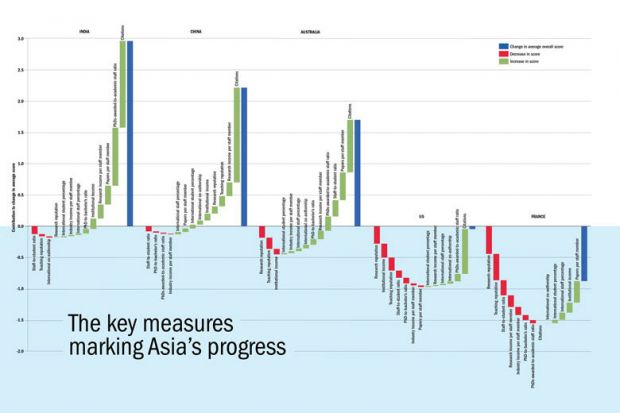Click here for larger version of graphs
Browse the full results of the World University Rankings 2018
The rise of Asian universities has been a constant refrain in global higher education over the past few years, but which areas of academic activity are key to the progress they are making?
These “waterfall” diagrams, based on the average scores for different countries in each of the 13 metrics underlying the Times Higher Education World University Rankings and drawn from THE’s DataPoints analytical tools, may begin to explain the reasons.
As well as the change in the country average for overall rankings scores between 2017 and 2018 (in blue), the red and green blocks show – in order of magnitude – how each metric contributed to that change.
An improvement in citation performance jumps out as being the crucial marker for those, such as China and India, on a large upward curve, with higher income per staff scores and, to a lesser extent, growing internationalisation also contributing to their advancement. China is also seeing improvements on research feeding through into higher reputation scores.
One slight drag on the performance of both countries is a drop in staff-to-student ratio scores.
On the other side of the coin, the rise of such countries is helped by the slower pace of growth, or in some cases backward steps, among universities in the West.
France stands out as a country that is struggling. This might represent the legacy of long-standing problems with its higher education system that reformers are now trying to address, but in the meantime its average reputation scores are slipping and its citations performance is static. The country’s universities have also suffered a hit on some income measures, although not, notably, in overall income per academic.
The US, meanwhile, bucks the pattern of better citations performance leading to overall progress. Its impressive leap forward in this area is almost completely cancelled out by its universities’ average reputation scores taking a knock. Its change in average income scores, possibly reflecting the financial struggles of public institutions, might also be a cause for concern.
There are, however, Western nations that appear to be keeping pace with the improvements seen in Asia. Australia, for instance, has recorded an impressive change in average overall score, fuelled by a solid citations and research productivity performance. The country seems to have been held back only by falling reputation scores for its universities.
Download a copy of the World University Rankings 2018 digital supplement
Find out more about THE DataPoints
THE DataPoints is designed with the forward-looking and growth-minded institution in view
Register to continue
Why register?
- Registration is free and only takes a moment
- Once registered, you can read 3 articles a month
- Sign up for our newsletter
Subscribe
Or subscribe for unlimited access to:
- Unlimited access to news, views, insights & reviews
- Digital editions
- Digital access to THE’s university and college rankings analysis
Already registered or a current subscriber? Login








